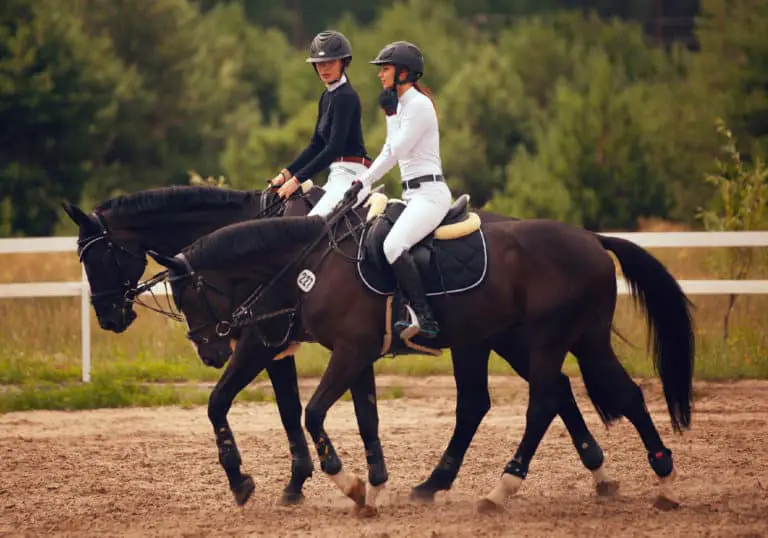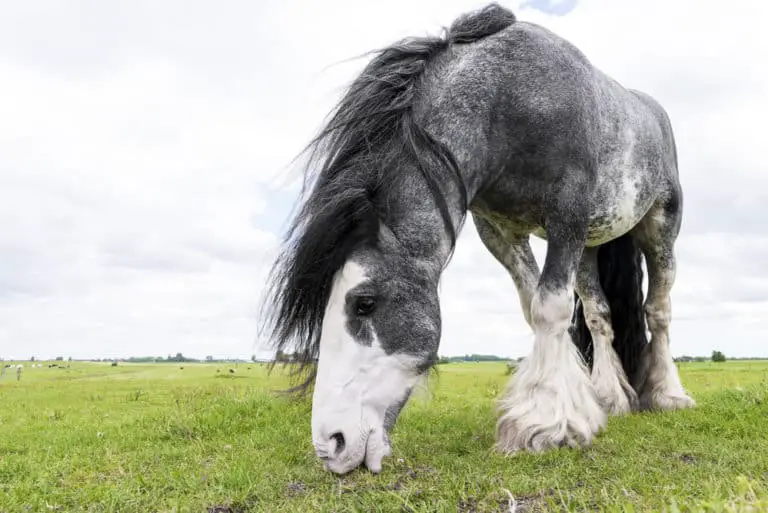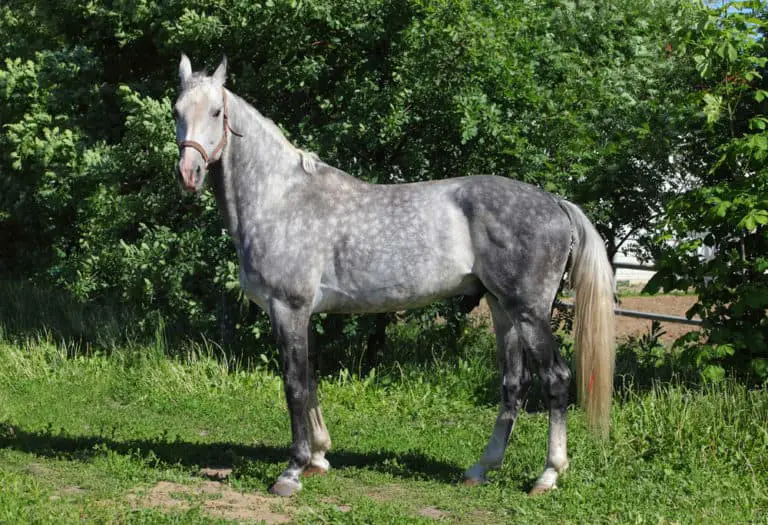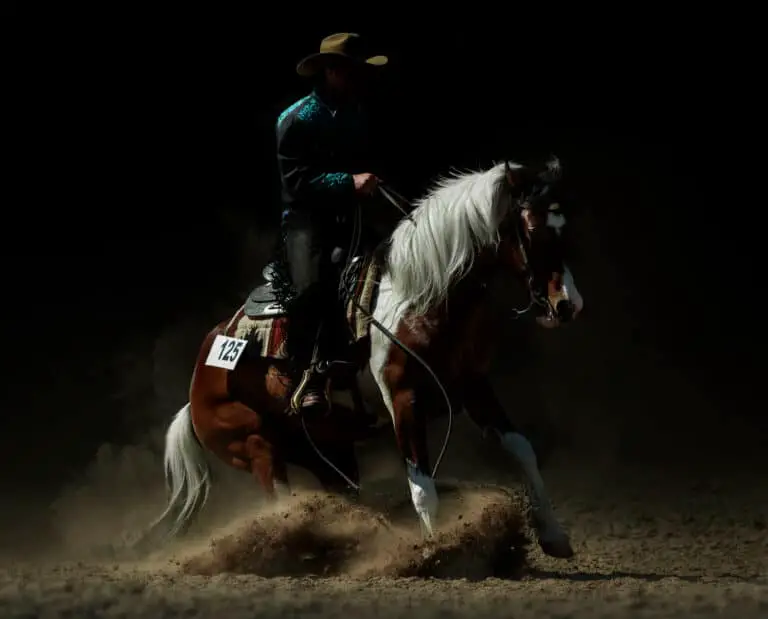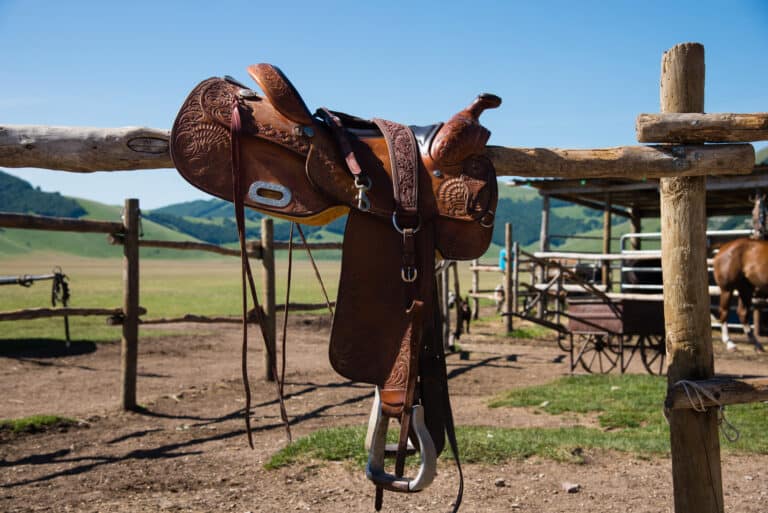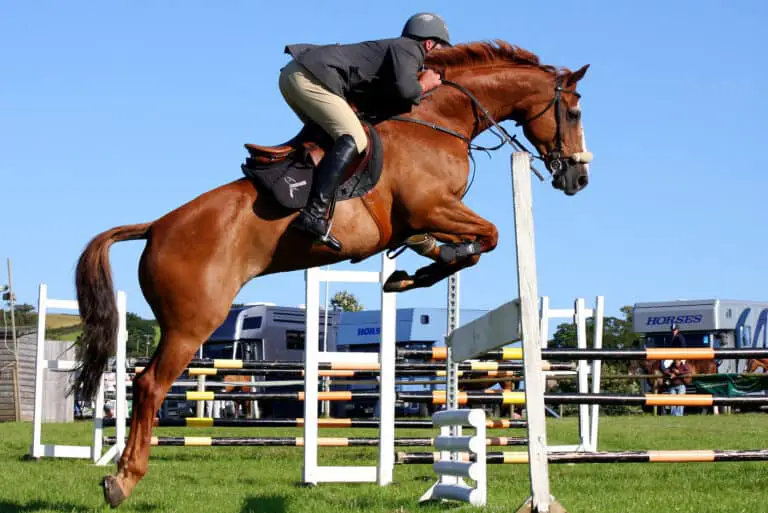Morgan Horse Breed: Care, Cost & History (2025)
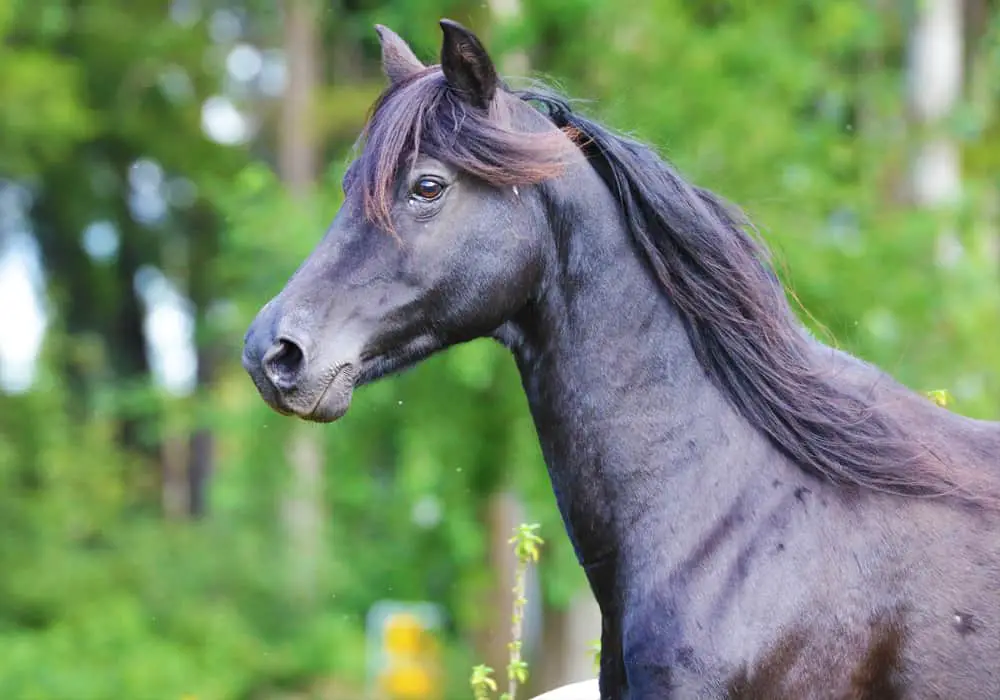
The Morgan horse is one of the first American breeds of horses. They originated in Vermont, and many are still found in New England, as well as throughout the United States and the world.
The breed is known for its versatility and personality. Morgans can truly do it all, from carrying a small child to pulling a cart.
Breed Profile
Breed: Morgan Horse
Adult Weight: 900 to 1,100 pounds
Adult Height: 14.1 to 15.2 hands
Origin: United States
Use: riding (English, Western, jumping, trail), driving
Colors: chestnut, black, bay, brown, palomino, buckskin, smoky black, cremello, perlino, smoky cream, dun, flaxen, silver, gray, roan, and pinto
Features: Beautiful head, Large, kind eyes, arched neck, short back, and compact size
Lifespan: 20-30 years
Character: Kind horses with outgoing personalities
Gait: Smooth and spirited
Best for: All levels of riders and any discipline
Morgan Horse Characteristics
The Morgan breed of horse is known for its consistent characteristics, they all look similar and it’s easy to identify a Morgan.
The breed was founded by one sire, Figure, later called the Justin Morgan Horse. His descendants all have beautiful heads with large eyes, arched necks, and strong, compact bodies.
Size
The Morgan breed is an average size, between 14.1 and 15.2 hands, according to the American Morgan standards. (1) Stallions are typically a little larger than mares, although this varies depending on the horse. Morgans typically reach their full height by three or four years of age.
Some Morgan horses are registered as ponies when they are 14.1 hands or smaller. Several have competed successfully in pony divisions of combined driving competitions.
A myth about Morgan’s size was that Figure was a small horse, but could outrun, out trot, and out pull any other horse in Vermont. Morgan horse height has not limited them from being successful in multiple disciplines.
Weight
The average weight of a Morgan horse is 900 to 1,100 pounds. Mares are typically lighter than stallions, closer to 900 pounds, but again, this depends on the horse. Foals are roughly 100 pounds at birth, and then quickly grow over the next few years.
Morgan horse weight is less than some other breeds because of their refined bone structure. Specifically, the legs have flat bones, are straight, with an adequate structure to support the horse.
Much of their weight is in the compact body, but it is graceful, strong, and athletic. The feet of the Morgan have always been proportionate to the size of the horse and adequately support their weight.
Colors
Morgan colors include chestnut, black, bay, brown, palomino, buckskin, smoky black, cremello, perlino, smoky cream, dun, flaxen, silver, gray, roan, and pinto. Flaxen and silver are primarily seen in the mane and tail on horses.
Originally, Morgan horses were bay, black, chestnut, and brown. The figure was a bay with no white markings, and his offspring had these same colors.
These are the dominant breed colors, and the others weren’t allowed for many years.
Now, many Morgan horse colors are allowed by the breed registry, and they can have more white markings or chrome. Although the other colors are rarer, dedicated breeders are ensuring that they are carried on.
Temperament
Morgan horses are alert, animated, and have good attitudes. They are known as “the horse that chooses you” because they love people and want to please us. Morgan behavior is easygoing, they are adaptable and enjoy working.
The horses are inquisitive and bond strongly with people. Their willing attitude makes them easy to train, and their versatility helps them excel in many disciplines. Morgan horses can be found in dressage, endurance, and in the show ring.
The United States Equestrian Federation (USEF) rules prohibit children (junior exhibitors) from showing stallions. (2)
The rule is in place for safety reasons, but children may still be able to show stallions at non-USEF shows. However, all Morgans are elegant in the show ring and share the joy of equestrian sports with their riders.
Morgan Horse Care
Caring for Morgan horses is fun, they thrive in backyard barns, show stables, and on working ranches.
Basic shelter, proper diet and nutrition, and regular veterinary and farrier care are needed.
Morgans love people and are adaptable and good-natured horses. They excel in any living conditions with a basic standard of care.
Diet and Nutrition
Morgan horses are known as easy keepers in the equine world. This means that they do not require a lot of extra feed and special attention to thrive. Forage, in the form of hay or grass, is the foundation of any horse diet, including for the Morgan. (3)
Grain or supplements must be added to make sure all nutritional requirements, including vitamins and minerals, are met. (3) Because they are known as easy keepers, Morgan horses need less feed than other regular-sized horses. (4, 5)
Morgan horses can quickly become overweight and develop insulin resistance issues. (6) Owners and caretakers are careful to ensure that their horses do not receive too much grass or grain (7)
Health Problems
Insulin resistance, also known as equine metabolic syndrome, is one of the most common Morgan health issues. (6) Prevention is one of the best ways to manage this health problem, although treatments are available for afflicted horses.
Prevention methods include maintaining an appropriate weight and limiting the horse’s exposure to high-sugar diets (7) These horses are also prone to Type 1 Polysaccharide Storage Myopathy; it causes muscle pain and weakness when sugars are stored in muscle cells.
Genetic problems in Morgan horses include an eye disorder called Multiple Congenital Ocular Anomalies that are found in horses with the silver dilution gene. It causes numerous eye issues including cysts, an enlarged cornea, and iris/retina issues. (8)
Grooming
Morgan grooming has similarities and differences to other breeds. First, they are easy horses to groom because they enjoy the attention.
Show horses have specific grooming requirements to prepare them for their classes, including clipping the horse’s bridle path, ears, muzzle, and legs.
The mane and tail on show horses also need to be carefully picked and presented in a long, flowing fashion. (9) Horses should be groomed a few times per week, and their feet should be picked out daily.
Grooming is important to bring out their shine and beauty, but that starts with the correct diet and nutrition and grooming enhances their beauty. (10)
Morgan Horse History
The figure, or the Justin Morgan Horse, was born in 1789 in Vermont. His three famous sons, Sherman, Bulrush, and Woodbury, carried on his bloodlines to help form the breed.
Morgan horses have played a role in many parts of our history, from early New England towns to exploring the west and building cattle ranches. (5)
Origin
Morgan horses history is 230-years old and closely tied to the United States. Their popularity has expanded beyond their New England birthplace to throughout the country and world, with active Morgan horse breed associations in Britain, Sweden, and Australia, among others.
The parents of Figure aren’t well known, but it is thought that he has Thoroughbred, Arabian, and Dutch bloodlines. His three most famous sons helped carry the breed forward, and numerous other offspring also contributed.
Morgans also helped find several other breeds of horses. The Morgan horse origin is in working on New England farms and pulling carriages to town and church. Family members also used them as riding horses.
Historic Development
Vermont is the birthplace of the Morgan horse and remains integral to the breed’s development. The figure, the foundation sire, was born in Massachusetts and then acquired by Justin Morgan, the man, as payment for a debt.
Travel was a little harder in 1789 than it is today, but Figure bred mares at multiple locations, and people quickly learned of the quality of the Morgan horses. The breed expanded throughout New England, then to other parts of the country, and finally, internationally.
Morgan horses were used in the Government remount program for the cavalry. The facility in Weybridge, Vermont was offered to the University of Vermont in 1951 and still has a Morgan breeding program.
Notable Morgan Horses
There are many famous Morgan horses. Marguerite Henry, an author, and Disney popularized the breed with Henry’s book, Justin Morgan Had A Horse.
Disney made it into a movie in 1972, and the story has delighted generations of equine enthusiasts. The breed was originally known for its versatility, and this has remained a constant.
Famous Horse – The Figure
The figure, the Morgan stallion known as Justin Morgan, is our first famous horse because he is the founding sire of the breed.
Horses were often called by the name of their owners in the 1700s. Figure’s ability to pass his genetics on to his offspring created a breed of horse that resembles him and has the same characteristics.
Famous Horse – Sherman Morgan
Sherman Morgan was the son of Justin Morgan born around 1808. He worked on the farm and pulled freight to Maine.
Sherman was small even for Morgan height, only 13 ¾ hands, it is believed that he was small because he started work so young. He had 44 sons and numerous daughters that contributed to the breed.
Famous Horse – Woodbury
The Morgan stallion Woodbury was born in 1816. He was said to be the finest of the three famous sons, the other being Bulrush.
Woodbury had perfect conformation, was 15 hands, and weighed around 1,100 pounds. He was sold to a man in Alabama and made significant contributions to the breed.
Myths and Legends
Figure’s story and the early origins of the Morgan breed are shrouded in myths and legends. Stories abound about the horse’s prowess both in the field and racing. We may never know how many of these legends are true, but we can be certain that he was a remarkable horse.
Superior Strength
The figure pulled a down tree that other horses couldn’t budge. This story was perpetuated in the movie, where Justin Morgan the man, considers what the horse needs to do. He has some of the other men sit on the opposite end of the tree to lift the front up, and then Figure pulls it out.
Impressive Speed
General Sheridan rode Rienzi, his Morgan horse, during the Civil War. A battle in Virginia in 1864 was considered crucial for the Union Army. General Sheridan was 12 miles away when it started, but Rienzi was fast and had the Morgan horse speed. They arrived at the battle in time to rally the troops and lead them to victory. (11)
Poetic Muse
The poet Robert Frost lived in Vermont; one of his poems is called The Runaway. It’s about a Morgan colt that’s afraid of snowflakes. The poem details the colt’s antics as he’s alone in a field when the snow begins to fall. One wonders if the colt later became a Morgan gelding.
Modern Morgan Horses
The beautiful Morgan horse remains a popular breed with equestrians for its personality, versatility, and family-friendly demeanor.
The Morgan horse temperament is well-known for being adaptable and easy-going.
The horses seem to know how to treat each person they interact with, being quiet and kind for a child and spirited for an adult.
Breeding
A trip to Vermont is a trip to Morgan country. They are the official state animal of Vermont, and a Morgan breeder is happy to call the state home. But the Morgan is popular wherever they are known.
There are four major bloodlines within the breed, including the Brunk Family, Lippitt Family, Government Family, and Working Western Family. Each of these bloodlines in the Morgan horse pedigree has unique attributes, but all trace back to Justin Morgan.
One of the differentiators is which famous son of Justin Morgan these horses trace back to. The Government Family is the largest and carried on by the University of Vermont and many other breeders.
Population
The Morgan horse population is growing. There are about 90,000 Morgan horses registered with the American Morgan Horse Association (2). The breed’s numbers are increasing, according to registry trends, as Morgan horse information reaches more audiences.
Most of the Morgan horses are in the United States, however, there are active organizations and breeders in several countries that are also breeding the Morgan horse. Exact statistics are unavailable, but the vast majority of Morgan horses breeding is still in the United States.
Although there are many Morgan horses throughout the world, they are on the critical list of the Livestock Conservancy (12) as many other breeds have larger registries.
Uses
If you can dream it, Morgan can do it. Morgan horse uses extend to whatever discipline their human wants to try.
They are one of the top breeds for carriage driving, can be found in working western disciplines, eventing, trail riding, in dressage, at therapeutic leadline programs, and in the show ring.
Morgan horse characteristics mean they are a truly versatile breed and can do it all.
In fact, it is quite common for a horse to have multiple careers throughout its life, as the Morgan horse lifespan is about 30 years, and they remain sound and eager to work and please their people.
The Morgan horse gait is smooth and comfortable to ride.
Morgan Horse Prices
Owning a Morgan horse is a long-term commitment. The purchase price of the horse is the first in line of costs that come with owning a horse.
Hay, grain, and bedding are ongoing expenses. Horses also need routine care from veterinarians, farriers, and equine dentists.
The joy of owning a horse makes the Morgan price worthwhile.
Purchase Price
The purchase price depends on the horse you are buying. Morgan horse foals cost less than a fully mature and trained horse. A champion Morgan horse in any discipline is going to cost more than a riding Morgan horse that is a teenager’s pet in the backyard.
Even with all these variables, the Morgan horse is an economical breed to purchase. You can expect to pay between $2,500 and $5,000 for a trained horse.
Younger horses with the potential to compete at the highest levels can cost up to $50,000 or more. An older horse retiring from a more strenuous career can cost less but may have an extra vet or hoof care costs.
Ownership Costs
Morgan horse price includes the purchase and annual board, feed, vet, and hoof care. These are not optional expenses; they are essential to the horse’s health and well-being.
Horse owners can expect to pay between $1,770 and $12,930 per year. The cost varies based on geographic location and availability of horse board, and types and amounts of feed.
Board
Paying board is the equivalent of your rent or mortgage. Board pays for your horse’s stall or run-in shed on another person’s property.
Prices range from $1,200 to $7,200 annually depending on the facility. You still need to factor in costs for repairs and property upkeep if you keep your horse at home.
Feed
Feed is the next biggest expense every horse owner has. Horses must have a consistent source of forage and grain to maintain their weight and energy.
Access to pasture reduces feed costs, whereas those in colder climates can expect to pay more. You can expect to pay between $250 to $4,380 annually for feed.
Vet Care
Vet care includes annual vaccinations, dewormer, and dental care completed twice per year.
The cost will range from $250 to $350 annually, but this assumes that your horse remains healthy and never gets injured.
Horse owners can have surprise bills for vet care of $500 to $1000 for one of these incidents.
Hoof Care
Equestrians have a popular saying, “no hoof, no horse.” Your horse will need routine hoof care to remain sound and healthy.
Hoof care occurs every six to eight weeks and the farrier will trim the horses’ feet, or trim and shoe them. The cost is between $120 and $1,000 annually, depending on the needs of the horse.
Buying a Morgan Horse
The Morgan horse personality tempts you to buy one right away. Do your homework first. Know your horse ownership goals and buy a horse that will help you accomplish those.
The Morgan is versatile, but they also have preferences, just like we do. Meet the horse first and try them out to be sure you’re a good match.
Is the Morgan Horse Right for You?
Yes, the Morgan horse is right for you if you find the right horse. Riding a Morgan horse changes your life and brings joy. Again, each horse is unique.
Match your personality to the Morgan horse characteristics, and then buy a horse. A person that has always dreamed of roping cattle would be happier with a Working Western Morgan than one of the other families.
Sure, any Morgan could do it, but you want the horse to be happy too. Similarly, Morgans can be enjoyed by all ages, but make sure you choose one with the temperament to match the use and person.
How to Buy a Morgan Horse?
Define your ideal horse to begin the Morgan horse buying process. Then start searching. The American Morgan Horse Association lists Morgan breeders and organizations on their website.
Visit people in your geographic region and learn more about Morgan. Try out multiple horses for sale, don’t buy the first one you look at. This gives you a better idea of what’s available, even if you later return and buy that first horse.
Look for horses that fit your goals and you enjoy riding or driving. The Morgan horse head is beautiful, but don’t buy just a pretty face.
Avoid horses with physical impairments, personality issues, or behavioral challenges. A pre-purchase veterinary exam can provide valuable information.
Similar Breeds to Morgan Horse
There Morgan horse was helped create several other breeds. Quarter Horses, Tennessee Walking Horses, and Standardbreds all trace their origin to the Morgan and are similar in size, appearance, personality, and versatility.
The Quarter Horse possesses the same versatility, while the Tennessee Walker has the appearance and personality of the Morgan. The Standardbred’s speed was also a Morgan trait.
American Quarter Horse
The American Quarter Horse is one of the most popular horse breeds in the world and the Morgan is part of their history.
Quarter Horses are known for their amiable personalities and versatility.
Quarter Horses are similar in size, stature, and color to the Morgan, and are also known for their burst of speedrunning a quarter-mile.
Tennessee Walking Horse
Tennessee Walking Horses are a breed that was developed to carry people across their plantations. They are known for their smooth, ground-covering gaits and are beautiful horses.
The average Tennessee Walking Horse is taller than a Morgan. The smooth gaits and big stride are similar to those of the Morgan horse.
Standardbred
Standardbreds are an American breed of horse used for harness racing. There are two types of Standardbred racehorses, trotters, and pacers.
The pace is a lateral gait where a set of legs (right or left) move together. This breed also has Morgan horses in its foundation stock, and we see similarities in the size, body characteristics, and speed.
FAQ
What is a Morgan horse?
The Morgan horse is an American breed known for its easy-going temperament, beauty, and versatility.
What does a Morgan horse look like?
Morgan horses have clean, straight legs, and compact bodies. They have a beautiful face with large eyes, fox-like ears, and an elegant neck tied into a flat topline.
How did the Morgan horse get its name?
The Figure was a horse owned by a man named Justin Morgan. The Figure became known as the Justin Morgan Horse. The breed adopted its name from him.
Can you ride a Morgan horse?
Yes. They are known for their versatility and are ridden English and western, jumping and dressage, and out on the trail.
Are Morgan horses good for beginners?
Morgan horses are great for beginners. They are kind horses and adapt to their riders and handlers, taking extra care of those that are new to horses.
How tall is a Morgan horse?
A Morgan horse is between 14.1 hands and 15 hands tall, or 57 to 61 inches tall when they are fully mature.
How much does a Morgan horse weigh?
A Morgan horse weighs between 900 and 1,100 pounds when they are fully mature.
How big is a Morgan horse?
A Morgan horse is an average size, they are not the biggest or smallest breed. Some Morgan horses qualify as ponies, at 14.1 hands or shorter.
How much does a Morgan horse cost?
A Morgan will cost between $2,500 and $5,000 although some cost more or less than that.
How much does a Morgan horse ownership cost?
The annual cost of owning a Morgan horse is between $1,770 and $12,930 per year.
How long do Morgan horses live?
Morgan horses live for 20-30 years.
How fast can a Morgan horse run?
Morgan horses can run approximately 20 miles per hour.
How much can a Morgan horse pull?
A Morgan horse can pull approximately 1,500 pounds.
How much can a Morgan horse carry?
A Morgan horse can carry about 200 pounds.
At what age is a Morgan horse full grown?
Morgan horses are usually fully grown at four or five years of age, although some may not be full-grown until age six.
What are Morgan horses used for?
Morgan horses are used for riding and driving. They are versatile and ridden English, Western, jumping, cutting, and on the trail.
References
- American Morgan Horse Association. 2022. Morgan Horse. Link
- U.S. Equestrian Federation. 2022. Morgan. Link
- American Association of Equine Practitioners, Lydia Gray, DVM, MA. 2016. Nutrition: The Key to Unlocking Your Horse’s Health. Link
- University of Georgia, Extension. 2015. How to Feed a Horse: Understanding the Basic Principles of Horse Nutrition. Link
- American Morgan Horse Association. 2022. FAQs – About the Morgan. Link
- Nicholas Frank, in Robinson’s Current Therapy in Equine Medicine. 2015. Equine Metabolic Syndrome. Link
- Holistic Horse, Frank K. Reilly, DVM, and Jenna E. Smedley, DVM. 2022. Answers for Insulin Resistant Horse. Link
- UC Davis Veterinary Genetics Laboratory. 2022. Morgan Horse. Link
- American Morgan Horse Association. 2022. So You Want To Show Your Horse! Link
- The Horse, Katie Navarra. 2019. Equine Detailing: Elevate Your Grooming Routine. Link
- Atlas Obscura. 2022. General Sheridan’s Horse Rienzi Winchester. Link
- The Livestock Conservancy. 2022. Morgan – Traditional. Link

